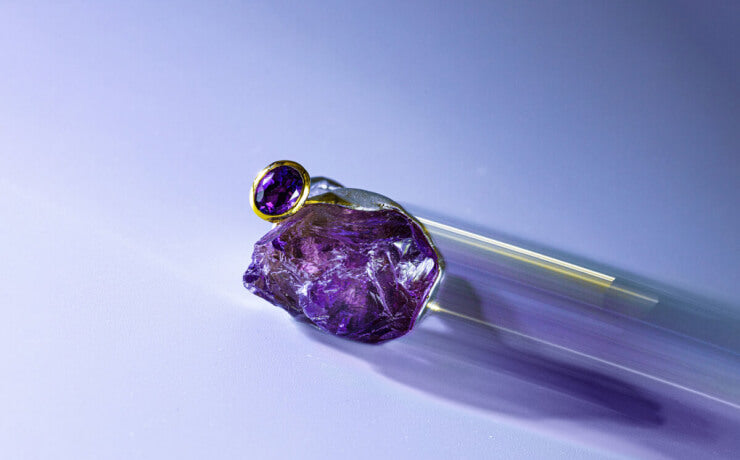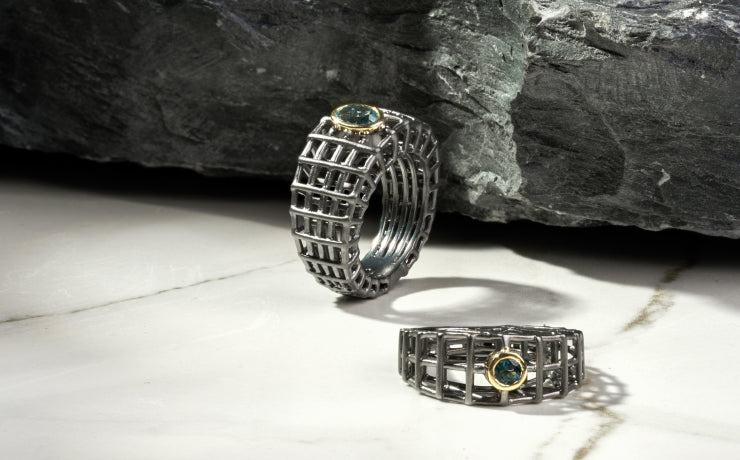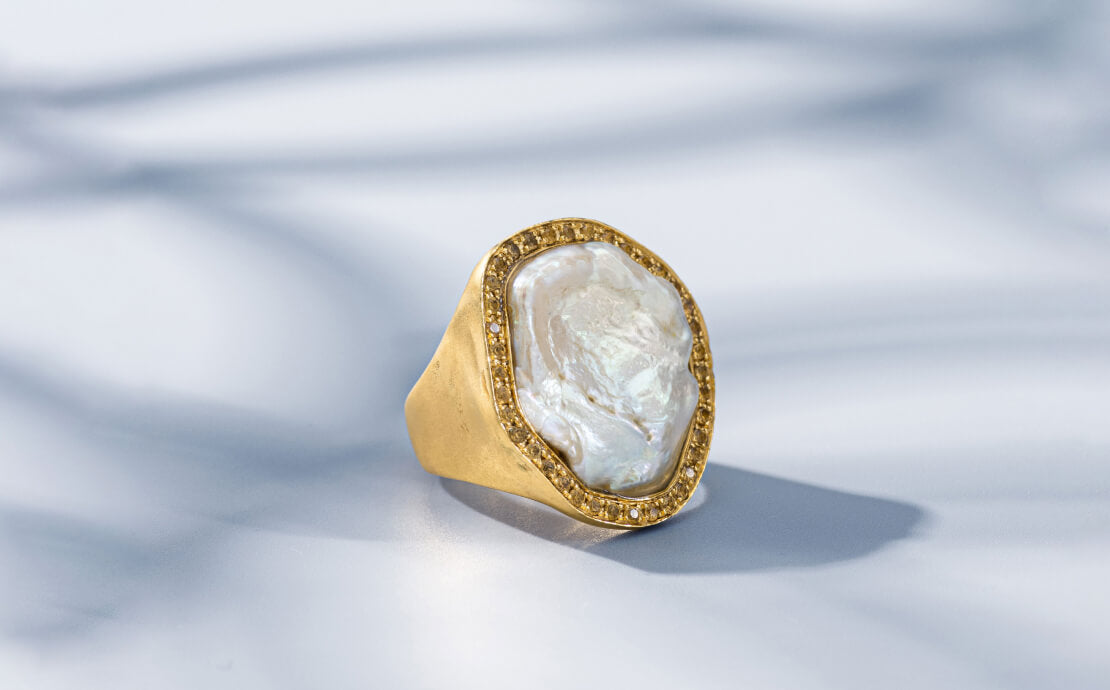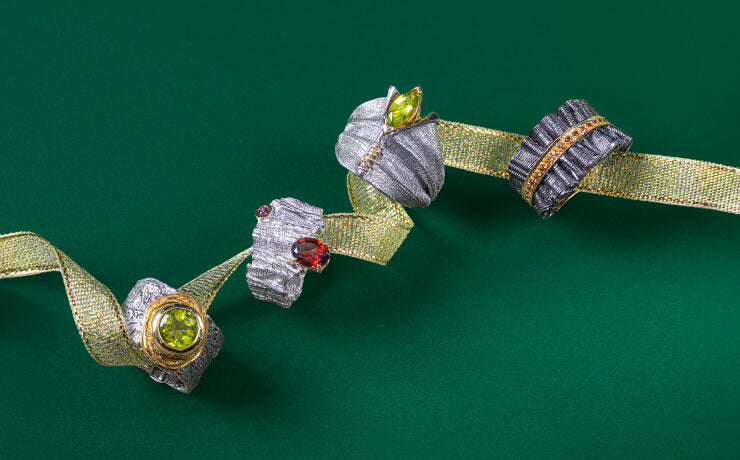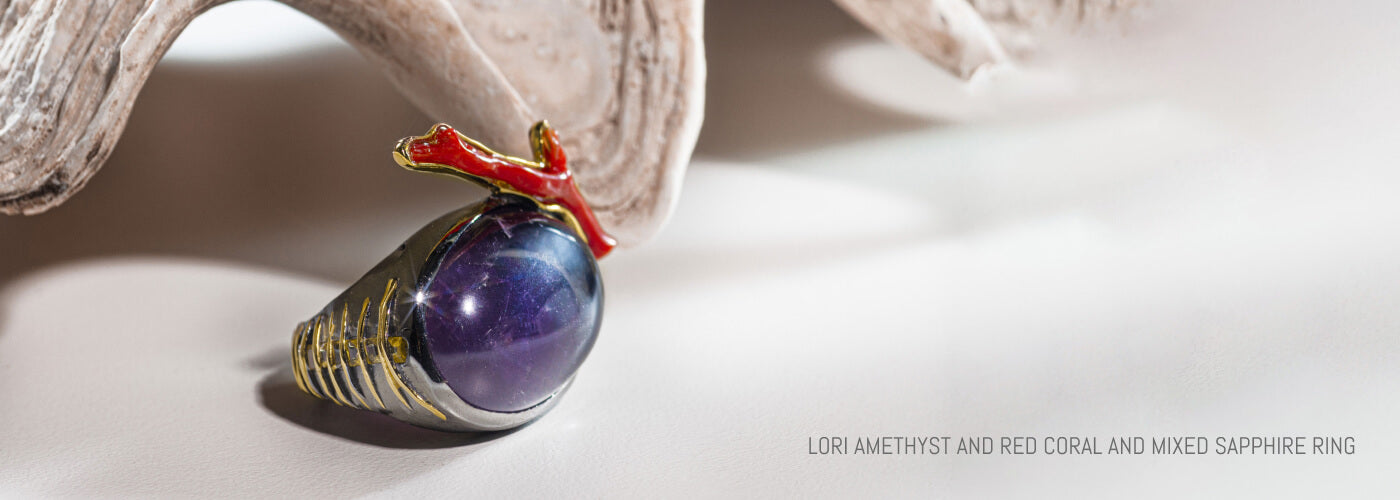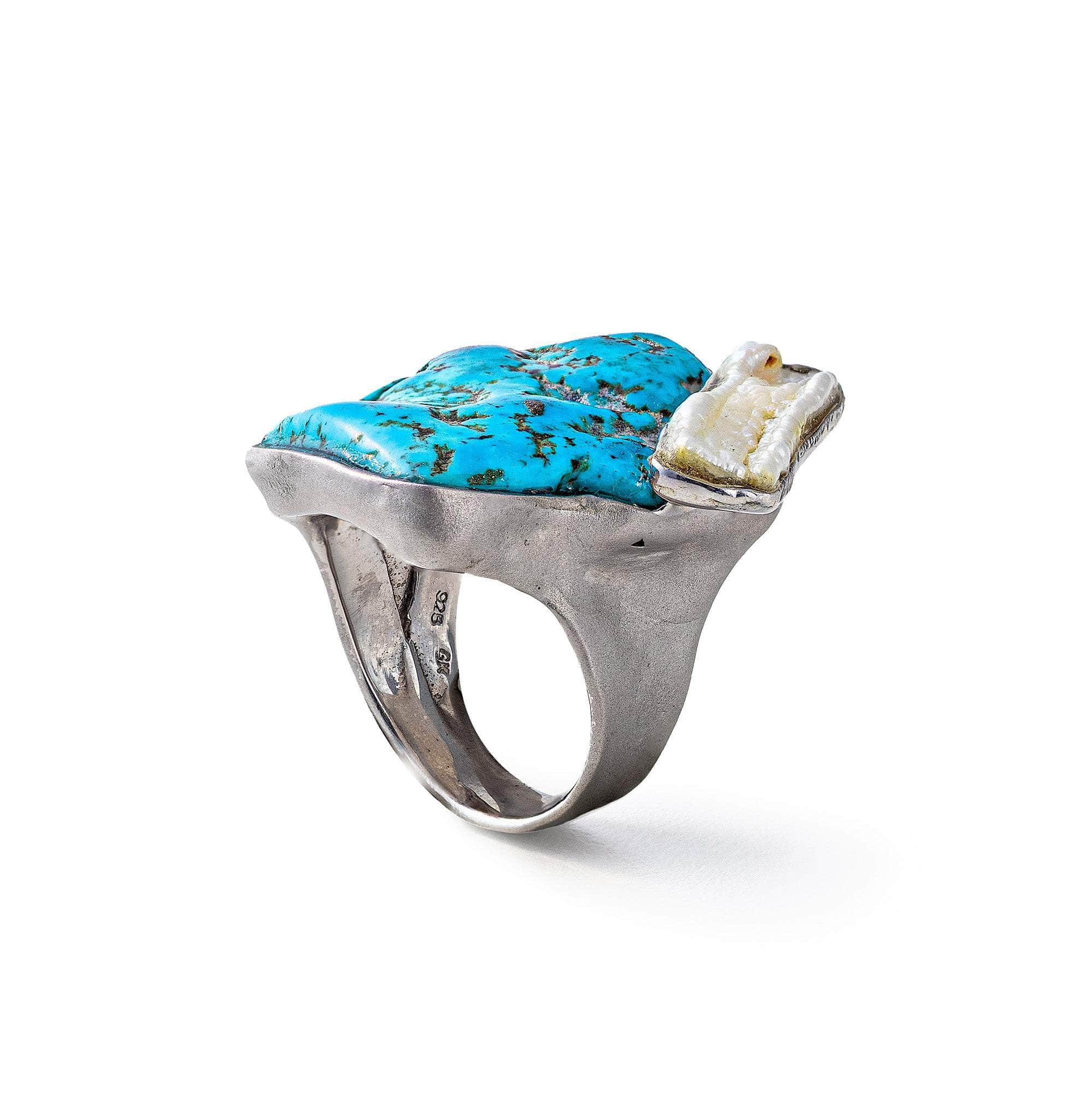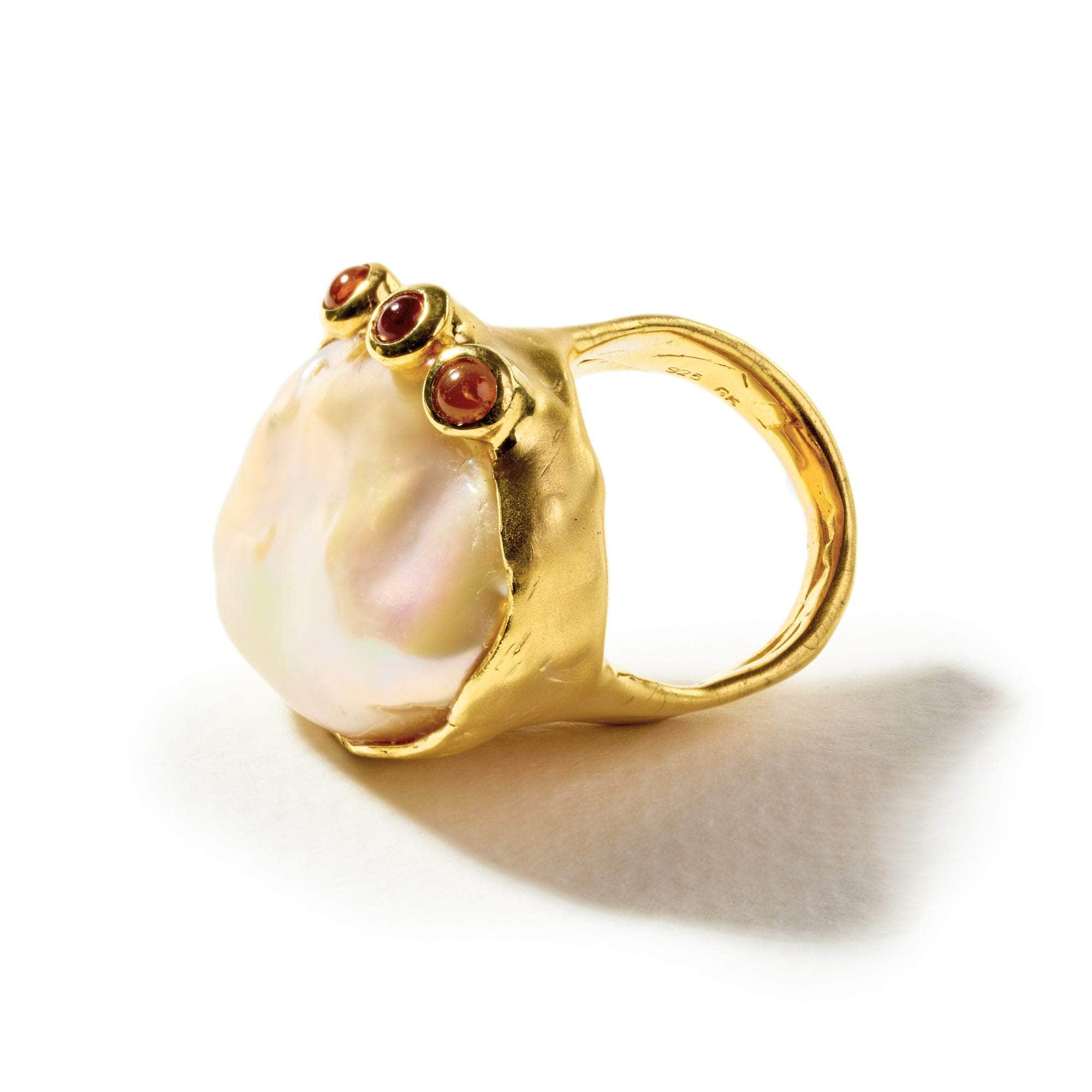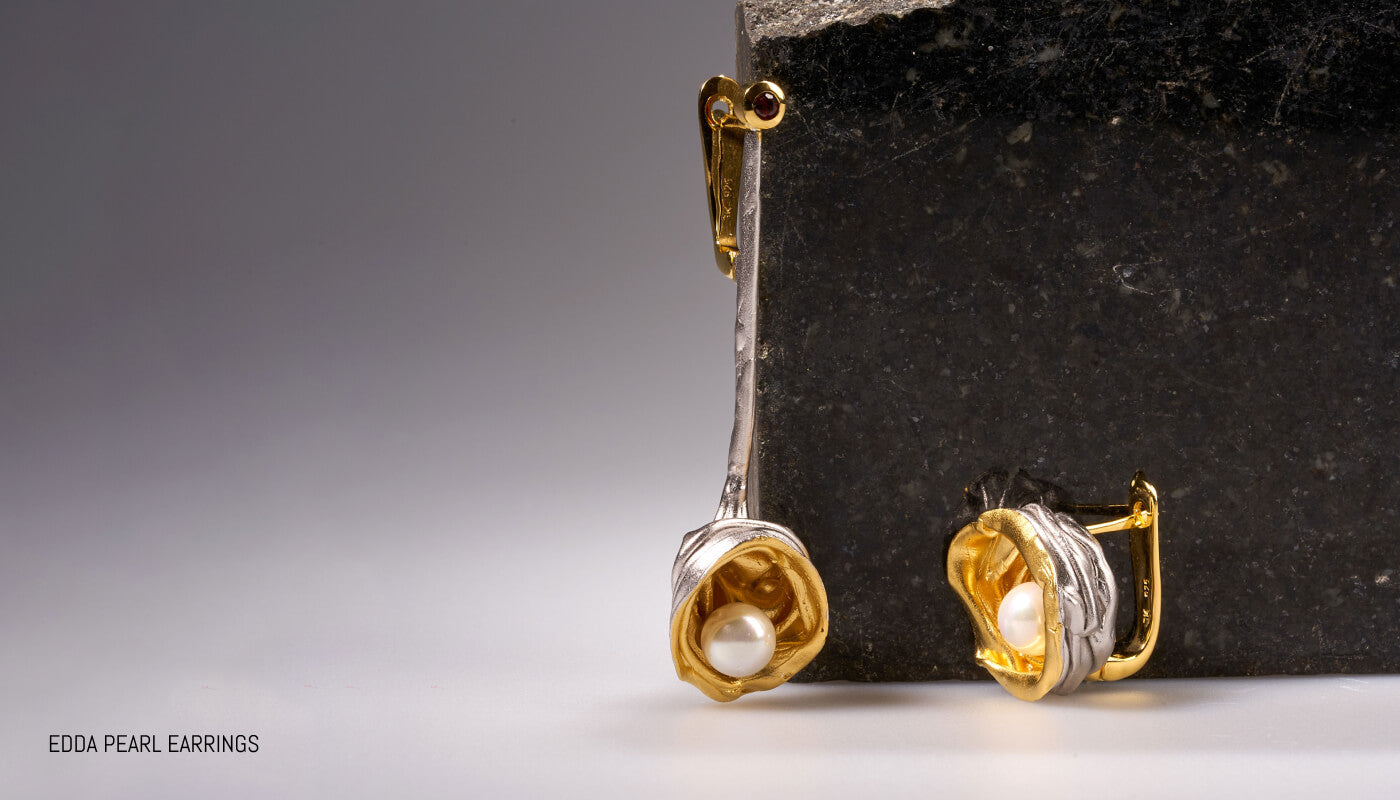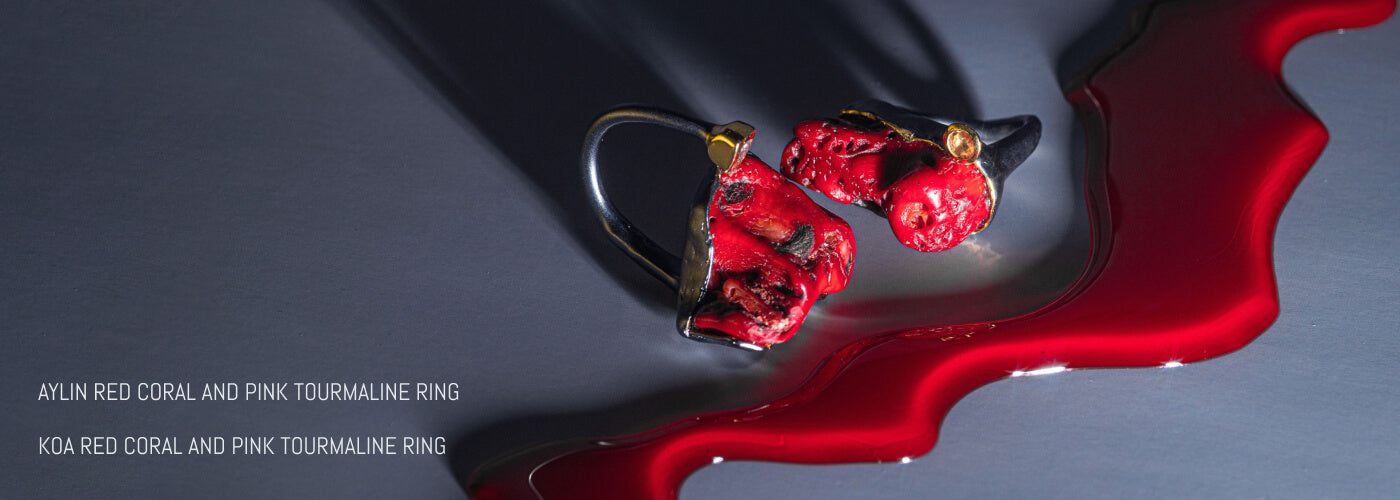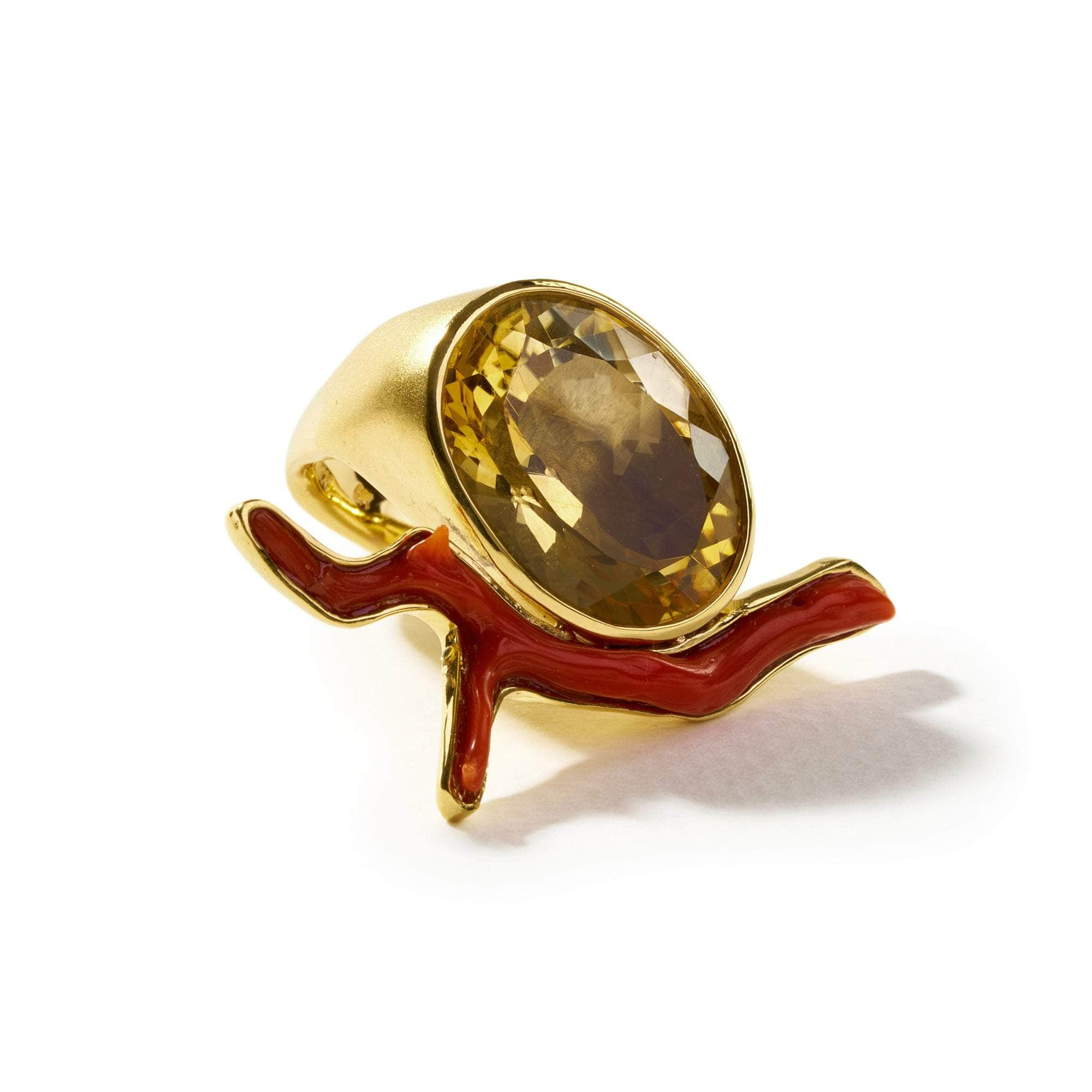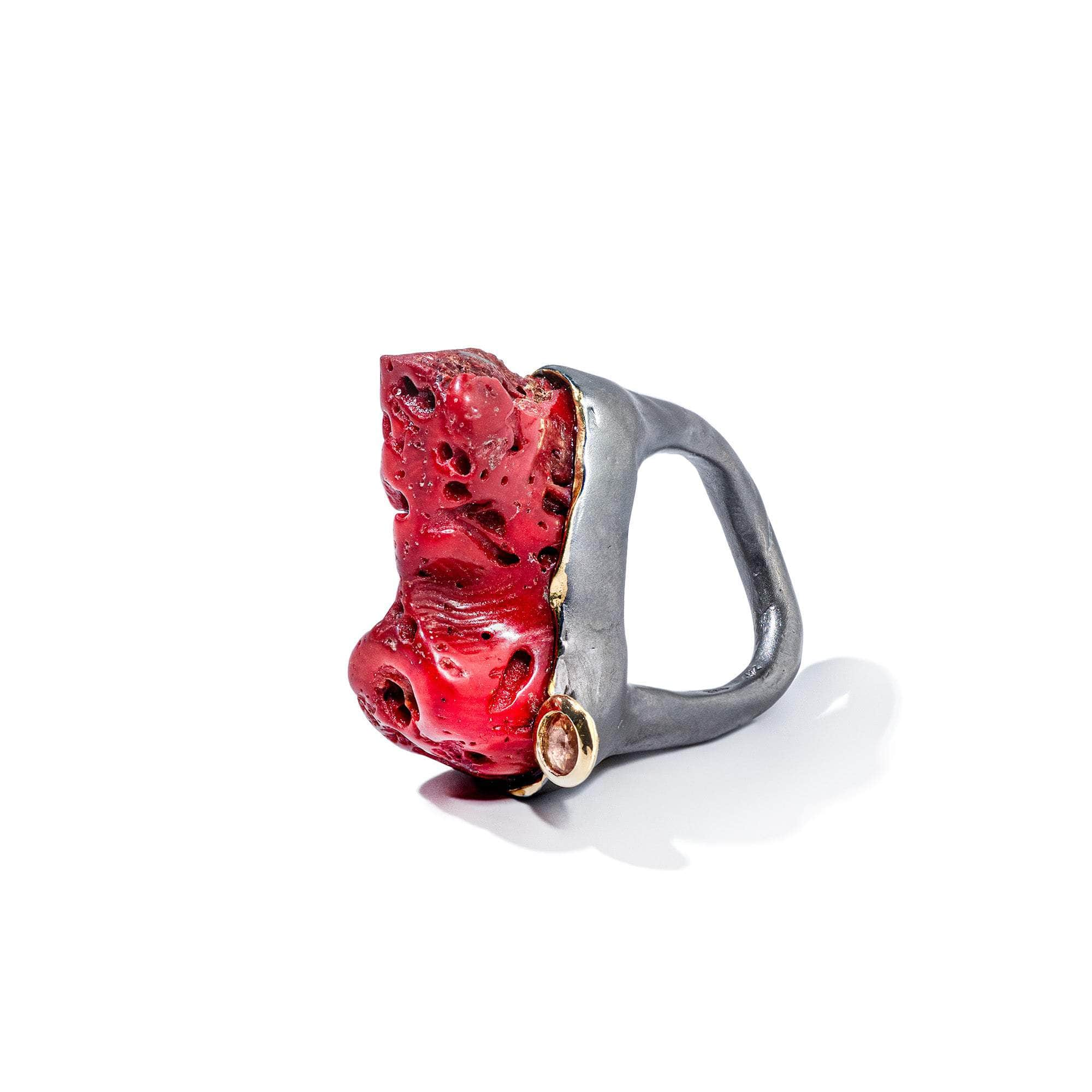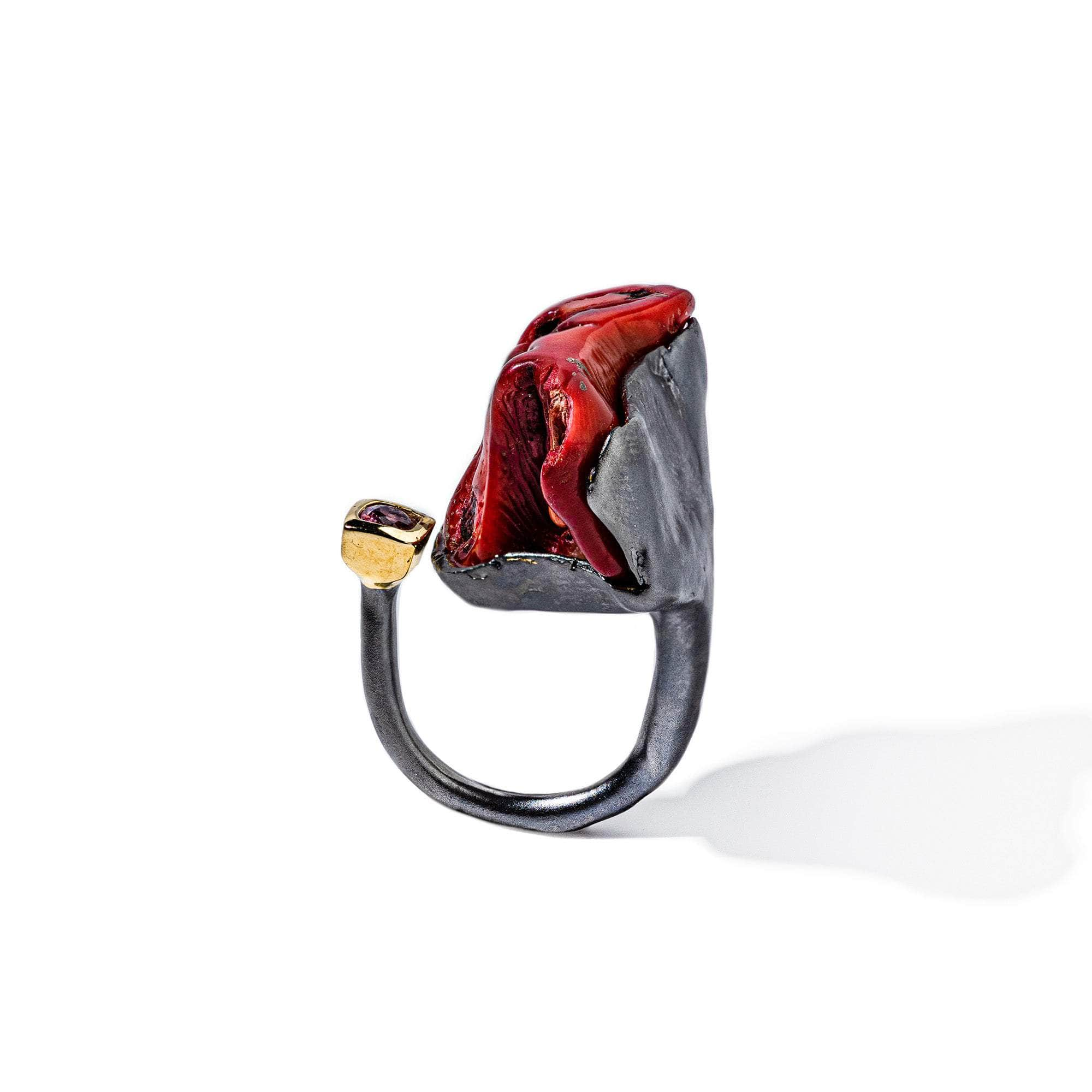All About Organic Gemstones
Pearl, Coral, Amber, Ammonite, and Bones in Modern Jewelry
In the vast world of gemstones, it's the organic ones that truly stand out, telling tales of the earth and sea. We're talking about pearls, coral, amber, ammonite, and bones – each with its own unique story and natural allure. Organic gemstones are the cool kids of the gem world, crafted not from the earth's depths but born from life itself. Imagine gems that aren't just dug up but have grown, lived, or even breathed. These gems, including pearls, coral, amber, ammonite, and bones, have a life story that sets them apart. While most gemstones are minerals, formed over eons under intense pressure and heat, organic gems take a different route. They come from living organisms or are formed by biological processes. Pearls are the glossy product of oysters' hard work, coral grows in the ocean's depths like an underwater garden, and amber is fossilized tree resin that has captured tiny snippets of ancient life. Ammonites are the remnants of prehistoric sea creatures, turned to stone, and bones carry the legacy of animals that once roamed the earth. This blend of life history and natural beauty makes organic gemstones uniquely fascinating, bridging the gap between the natural world and our desire to keep its beauty close.
These gems have more than just looks; they carry weight in history and culture. They've adorned kings and queens, been buried as treasures, and worn as symbols of status and protection. Fast forward to today, and they're still making waves in the fashion world, celebrated for their ecological footprint and their one-of-a-kind beauty. This isn't just about adorning oneself with pretty things; it's about making a statement with pieces that are as eco-friendly as they are enchanting.
Pearls whisper of the ocean's calm, forming layer by layer inside oysters. Coral takes us to the vibrant life under the sea, with its rich colors and textures. Amber is like nature's time capsule, trapping ancient secrets and prehistoric life within its golden depths. Ammonites, with their spiral shapes, are the fossils of ancient marine animals, linking us to the distant past. And bones remind us of the animal kingdom's enduring beauty and strength.
The Controversy Behind Organic Gemstones: Ethical Dilemma or Sustainable Future?
The conversation around organic gemstones — pearls, coral, amber, ammonite, and bones — touches on deep ethical concerns that are very much a part of today's environmental and ecological agenda. The crux of the controversy lies in the balance between appreciating natural beauty and preserving the ecosystems from which these materials are sourced. This debate is not black and white but filled with shades of gray, reflecting the varied perspectives of stakeholders involved.
One of the most pressing issues is the environmental impact of coral harvesting. Coral reefs are crucial for marine biodiversity, acting as the ocean's lungs and providing essential services such as coastal protection and fishery support. The extraction of coral for jewelry risks damaging these delicate ecosystems, leading to loss of habitat and biodiversity. Critics question whether the aesthetic value of coral jewelry can ever outweigh the environmental cost of its extraction, sparking a significant debate within conservation circles.
Pearl farming, too, has its ethical dilemmas. While it's promoted as a more sustainable alternative to wild pearl harvesting, concerns about the welfare of mollusks and the potential for environmental degradation remain. The debate extends to the impact of pearl farms on local ecosystems, including water pollution and the spread of diseases among wild and farmed mollusk populations. The question arises: Can pearl farming be managed in a way that truly minimizes harm to marine environments?
The collection of amber and ammonite raises questions about the balance between commercial interests and scientific value. These organic gemstones provide invaluable insights into Earth's history, but their popularity in jewelry can lead to overexploitation. The ethical debate here revolves around how to ensure that the pursuit of these gems does not strip future generations of the chance to study and learn from these natural archives. Finally, the use of bones and ivory in jewelry brings to the fore issues of wildlife conservation and animal rights. Despite international regulations like the CITES agreement, the illegal trade of ivory continues to pose a threat to elephant populations. This situation forces a reconsideration of how animal-derived materials are used in jewelry, pushing for ethical sourcing practices that do not contribute to the endangerment of species.
These ethical and sustainability concerns surrounding organic gemstones are real and pressing. They challenge consumers, designers, and policymakers to think critically about the origins of the materials they cherish and the impact of their choices on the planet. The ongoing debate emphasizes the need for transparent sourcing practices, stricter regulations, and a collective move towards more sustainable and ethical jewelry production methods.
Sustainable Practices at German Kabirski: Respecting Nature with Every Gemstone
At German Kabirski, our commitment to the environment and ethical practices is at the core of everything we do, especially when it involves organic gemstones. We understand the concerns surrounding the use of natural resources in jewelry making, particularly the impact on marine life and ecosystems. That's why our approach to incorporating organic materials like coral into our designs is deeply rooted in sustainability and respect for nature.
When it comes to coral, we steer clear of contributing to the depletion of coral reefs, which are vital for marine biodiversity. Our solution is to repurpose existing coral pieces, sourced from second-hand jewelry collected at Asian flea markets. This method allows us to breathe new life into old materials without further harming ocean life. These repurposed corals are transformed into exclusive, one-of-a-kind pieces, ensuring that each creation is special without necessitating mass production or new extraction from the sea. This practice not only aligns with our eco-conscious values but also adds a layer of unique history and story to our jewelry.
Ivory is a material we have chosen not to use in any of our designs. The ethical implications and the tragic impact of ivory trade on elephant populations are issues we take seriously. By excluding ivory from our materials list, we stand against wildlife exploitation and contribute to the global effort to protect these majestic animals.
Our use of pearls is carefully considered, with a commitment to sourcing from vetted suppliers known for their sustainable practices. We engage in thorough checks to ensure that our suppliers adhere to the highest standards of environmental stewardship and ethical treatment of marine life. This diligence allows us to offer our customers beautiful pearl pieces that they can wear with pride, knowing they support responsible and sustainable jewelry production.
At German Kabirski, we share your concerns about ecology and sustainability. We're constantly seeking ways to minimize our environmental footprint and make positive contributions through our creations. It's not just about making beautiful jewelry; it's about doing so in a way that honors and preserves the natural world for future generations.
Natural Pearls in German Kabirski Designs
At German Kabirski, our fascination with pearls transcends traditional boundaries. We're not just fans of these lustrous gems; we're passionate innovators, constantly exploring unconventional ways to showcase their beauty in modern jewelry. Unlike the classic string of pearls or the solitary pearl pendant, our designs break the mold, combining creativity with the natural charm of pearls to craft pieces that are truly avant-garde.
Our repertoire of pearls is as diverse as our designs. We predominantly use freshwater pearls, celebrated for their variety and accessibility, making them perfect for our experimental designs. Freshwater pearls come in an array of shapes from the perfectly round to the intriguingly irregular baroque pearls, each adding a unique texture and form to our creations. The round pearls bring a touch of classic elegance, seamlessly integrated into unconventional settings, while the baroque pearls, with their distinctive shapes, lend themselves to the creation of truly one-of-a-kind pieces.
Delving deeper into the pearl spectrum, we embrace the delicate beauty of keshi pearls, known for their unique shapes and lustrous sheen. These pearls, formed without a nucleus, are all nacre, giving them an extraordinary luster. Meanwhile, micropearls add a subtle sophistication to our designs, offering a refined elegance that complements the boldness of our larger pieces. On the rarer side, we occasionally incorporate sea pearls like those from Tahiti or South Sea into our exclusive gold designs, bringing a touch of exotic luxury to our collections.
Currently, we're excited to be working on a collection featuring micropearls. This upcoming series promises to highlight the delicate allure of these tiny treasures in ways that challenge traditional jewelry norms. By focusing on micropearls, we aim to showcase our dedication to detail and our commitment to pushing the boundaries of jewelry design.
At German Kabirski, pearls are more than just an adornment; they're a canvas for creativity. Our unconventional approach allows us to experiment with the material in ways that defy expectations, making each piece a statement of innovation and elegance. Stay tuned for our micropearl collection and experience the next chapter in our journey of redefining modern jewelry with natural pearls.
Repurposing Red and Black Corals for German Kabirski On-Off Jewelry Pieces
At German Kabirski, our approach to jewelry design is anything but ordinary, especially when it comes to incorporating elements like red and black corals. These materials, rich in history and allure, offer a canvas for innovation and artistry. By choosing to work exclusively with repurposed corals, sourced from antique markets, we ensure that our creations are not only unique but also environmentally conscious. Our production base in Bangkok, Thailand, positions us perfectly to explore these markets, uncovering treasures that inspire our one-off designs.
Red Coral
Red coral, scientifically known as Corallium rubrum, is a species of precious coral that's found primarily in the Mediterranean Sea and certain areas of the Atlantic Ocean. It's distinguished by its striking red or pink skeleton, which is composed of calcium carbonate and is used by the coral to support and protect itself. Unlike the coral reefs that build vast underwater structures, red coral grows in dark underwater crevices and cliffs, forming compact, branching structures. It has been valued for centuries in jewelry, ornaments, and as a protective talisman. Historically, red coral was believed to cure madness, protect from poison, and stop bleeding. Today, it's sought after for its vibrant color and rarity, often polished and shaped into beads or carved into intricate designs for jewelry. The harvesting of red coral is subject to strict regulations to prevent overexploitation and ensure the sustainability of coral populations.
Black Coral
Black coral, belonging to the order Antipatharia, is a type of coral that's known for its distinctive dark color, which can range from black to brown. Unlike red coral, black coral's color comes from the chitin-based skeleton rather than calcium carbonate. These corals thrive in deeper waters, from shallow seas to depths of thousands of meters, often in underwater canyons or slopes where currents are strong. Black corals are unique not only in their appearance but also in their biology; some species can live for thousands of years, making them among the oldest living marine organisms known. They have been used in jewelry and as amulets, with their branches polished and carved into elegant pieces. The allure of black coral lies in its mysterious appearance and the depth of its color, making it a prized material for high-end and exclusive jewelry designs. Like red coral, black coral is also regulated to prevent overharvesting, with a focus on protecting these ancient creatures of the deep.
Our commitment to repurposing red and black corals is a testament to our dedication to innovation, sustainability, and ethical design practices. Each piece we create is a one-off, designed not just to adorn but to make a statement about the value of preserving the beauty of our natural world. With our unique position in Bangkok, we continue to explore the rich heritage of these corals, transforming them into modern masterpieces that speak to the discerning jewelry lover.
Prehistoric Elegance: Ammonite and Fossils in German Kabirski Designs
German Kabirski's collection stands apart through its embrace of not just unique materials, but pieces of history itself. Ammonite fossils, alongside a carefully selected range of other ancient fossils, are central to this distinctive approach. These ancient relics, including the spiral-shaped ammonites and various other fossilized forms, offer a glimpse into the prehistoric past, bringing the beauty of ancient marine life to modern jewelry.
Our selection of fossils goes beyond ammonites, incorporating a variety of prehistoric specimens. Each fossil is chosen for its ability to tell a story—whether it's the age-old spirals of an ammonite or the detailed imprint of an ancient plant or animal. These pieces are set into jewelry that honors their unique characteristics, transforming them into one-of-a-kind designs. The use of such fossils is not just about adornment but making a statement of appreciation for the earth's vast history.
Integrating ammonites and other fossils into our designs, German Kabirski aims to create jewelry that is not merely worn but experienced. By doing so, we provide our customers with the opportunity to carry a piece of the earth's history with them, making each jewelry item a conversation starter and a testament to the timeless allure of nature's creations.
Nature's Legacy: The Future of Organic Gemstones in Modern Jewelry
As we reach the end of our exploration into the fascinating world of organic gemstones, it's clear that these natural treasures offer more than just aesthetic value; they carry with them stories of the earth, the sea, and life itself. German Kabirski's commitment to incorporating pearls, corals, ammonites, and other fossils into jewelry designs not only showcases a reverence for the natural world but also paves the way for a more sustainable and ethical approach to jewelry making. By choosing repurposed materials, engaging with ethical suppliers, and valuing the unique beauty of each organic gem, we underscore a broader movement towards responsible fashion and environmental stewardship.
The journey of organic gemstones from nature to adornment is filled with challenges and considerations, yet it remains a testament to human creativity and nature's unmatched artistry. As we look to the future, the role of organic gemstones in jewelry will undoubtedly evolve, guided by ongoing debates around sustainability and ethics. However, one thing remains certain: the allure of organic gemstones, with their rich textures, vibrant colors, and deep historical roots, will continue to inspire and captivate. Through innovative design and mindful practices, we can honor the legacy of these natural wonders, ensuring they remain a cherished part of our cultural heritage and personal expression for generations to come.
